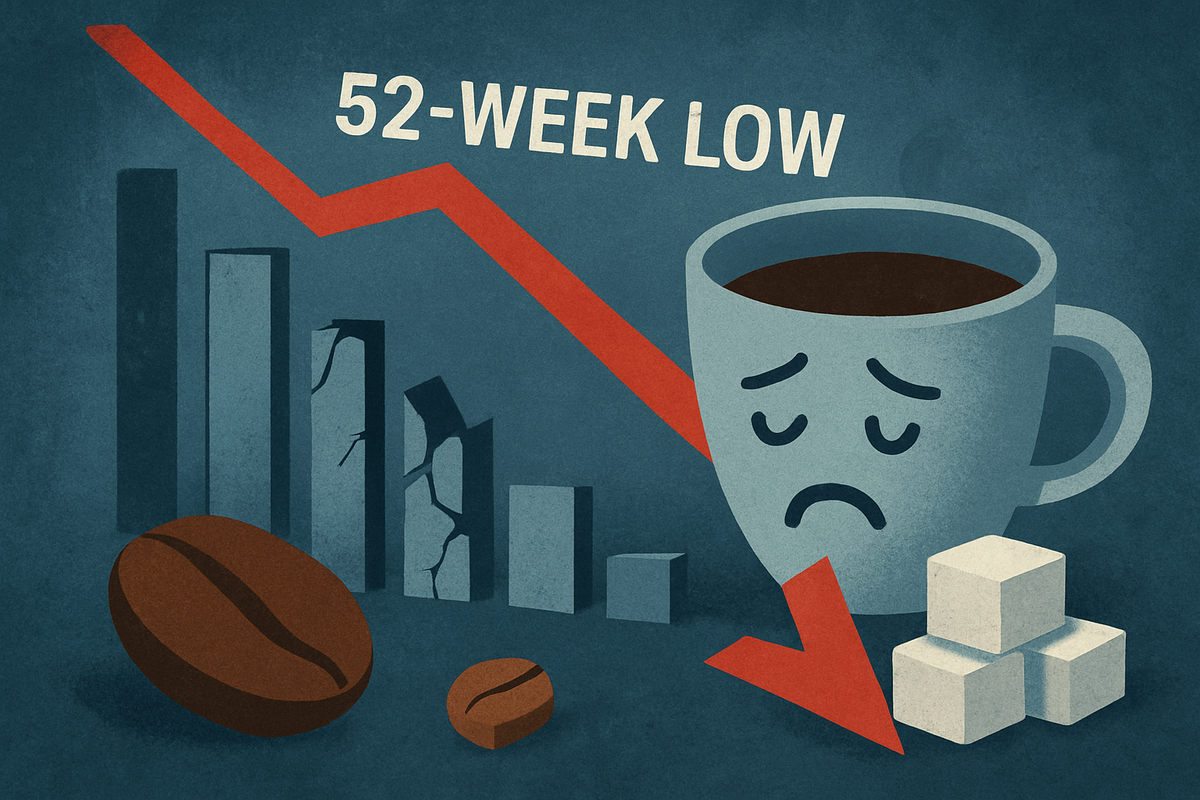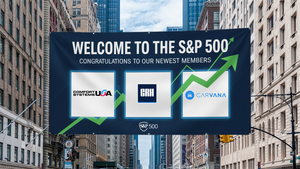
Keurig Dr Pepper (NASDAQ: KDP) has recently seen its stock tumble to a 52-week low, sending ripples of concern through the beverage industry and among its investor base. The significant downturn, observed in late September and early October 2025, represents a more than 30% decline over the past year and signals a challenging period for the prominent coffee and beverage giant. This dramatic drop is largely attributed to a combination of a poorly received strategic acquisition and persistent inflationary pressures from key commodity inputs, most notably coffee.
The immediate implications for Keurig Dr Pepper are substantial, as the company grapples with investor skepticism regarding its financial leverage and future strategic direction. The market's reaction underscores a cautious sentiment towards companies undertaking large-scale M&A activities, especially when coupled with an environment of rising operational costs. As the company navigates these headwinds, stakeholders are keenly watching how KDP will manage its debt, integrate its new acquisition, and mitigate the impact of volatile commodity markets on its profitability.
Acquisition Jitters and Commodity Headwinds Drive KDP's Decline
The precipitous fall of Keurig Dr Pepper's stock to a 52-week low, reaching around $25.34-$25.37 in late September and early October 2025, was primarily ignited by the company's ambitious, albeit controversial, acquisition announcement. In late August 2025, KDP unveiled plans to acquire the Dutch coffee conglomerate JDE Peet's for an estimated €15.7 billion ($18.4 billion) in an all-cash transaction. This deal, which offered a substantial 33% premium over JDE Peet's 90-day average share price, was to be financed through a bridge loan, immediately raising red flags for investors concerned about KDP's escalating debt load and potential overleveraging.
Following the announcement, KDP's stock plummeted by 17.7% within two days and continued its downward trajectory in subsequent weeks, fueled by what analysts described as "elevated noise and uncertainty." Major financial institutions, including TD Cowen, Barclays, Piper Sandler, BNP Paribas Exane, and UBS, responded by downgrading KDP's stock and revising down their price targets. Barclays, for instance, shifted its rating from 'Overweight' to 'Equalweight,' citing the "controversial mechanics" of the deal and the "exceedingly bad taste in the investment community's mouth." Further complicating matters, KDP's intention to split into two independent, U.S.-listed entities post-acquisition—one focused on global coffee and the other on North American beverages—sparked concerns over significant transition costs and operational complexities that could dilute the anticipated $400 million in annual cost synergies.
Beyond the acquisition, persistent commodity input costs have served as a significant underlying headwind for Keurig Dr Pepper, particularly the surging prices of green coffee. Arabica coffee prices, a critical input for KDP's U.S. coffee segment, climbed by approximately 80% in the six months leading up to February 2025. This sharp increase was driven by adverse weather conditions in Brazil and tariff-related uncertainties, directly impacting KDP's cost of goods sold. In response, KDP implemented price increases in late 2024, effective January 2025, with many competitors following suit. However, commodity prices continued their upward trend, intensifying the pressure on the company's margins. The U.S. coffee business unit reported declining sales in 2024 and the first quarter of 2025, and commodity inflation is expected to become even more pronounced in the latter half of 2025 as higher-cost green coffee hedges mature. While sugar is a general commodity input, the immediate and specific driver of recent pressures highlighted in research has been coffee.
Despite the sharp decline, some technical indicators suggest that KDP's stock is currently in oversold territory, potentially indicating a future rebound. The company continues to report healthy gross profit margins of around 55% and has maintained a consistent dividend yield, which could appeal to long-term investors. Interestingly, some institutional investors have reportedly begun accumulating shares, suggesting a belief that the stock may be undervalued at its current levels, setting the stage for a potential battle between bearish sentiment and value-seeking investors.
Industry Players Brace for Ripple Effects
The challenges facing Keurig Dr Pepper (NASDAQ: KDP) as its stock hits a 52-week low will undoubtedly send ripple effects across the beverage industry, creating both winners and losers among its competitors, suppliers, and even consumers. KDP, a significant player in both the hot and cold beverage markets, holds substantial market share in single-serve coffee and various soft drink categories. Its struggles can open doors for rivals or intensify competition, particularly in segments where KDP has a strong presence.
Potential Losers:
- Keurig Dr Pepper (NASDAQ: KDP): The most immediate loser is KDP itself. Beyond the direct impact of a depreciating stock value, the company faces increased scrutiny over its financial health due to the substantial debt taken on for the JDE Peet's acquisition. A higher debt load could limit its flexibility for future investments, share buybacks, or even dividend growth. The integration of JDE Peet's, coupled with the planned two-entity split, introduces significant operational risks and potential disruptions. If the anticipated synergies do not materialize as expected, or if integration costs exceed projections, KDP's profitability could be further strained. Furthermore, if consumers react negatively to price increases implemented to offset commodity costs, KDP could see a decline in sales volume, particularly in its coffee segment, which has already reported declining sales in 2024 and Q1 2025.
- Coffee Bean Suppliers: While rising coffee prices initially benefit suppliers, a financially constrained KDP or one facing reduced consumer demand might eventually lead to renegotiations or a reduction in order volumes. If KDP struggles to pass on costs, it might seek more aggressive pricing from suppliers, potentially squeezing their margins in the long run.
- Consumers: Consumers could also lose out in the short term. As KDP and potentially other beverage companies continue to implement price increases to counteract commodity inflation, consumers will face higher costs for their favorite coffee and soft drink products, potentially reducing purchasing power or forcing them to trade down to private-label alternatives.
Potential Winners:
- Competitors in the Coffee Market: Rivals in the coffee segment, such as Starbucks (NASDAQ: SBUX), Nestlé (OTC: NSRGY), and even smaller, artisanal coffee brands, could potentially gain market share if KDP struggles. If KDP's price increases make its products less competitive, or if its brand image suffers due to financial instability, consumers might shift to alternative coffee options. Competitors with more robust supply chain hedging strategies or less reliance on specific volatile commodities might find themselves in a stronger competitive position.
- Competitors in the Soft Drink Market: In the broader North American beverage market, competitors like Coca-Cola (NYSE: KO) and PepsiCo (NASDAQ: PEP) could capitalize on any perceived weakness from KDP. If KDP's focus is diverted by the JDE Peet's integration and debt management, these giants could expand their market presence or introduce new products to capture disaffected KDP consumers.
- Private Label Brands: In an environment of rising prices for branded products, private-label or store-brand coffee and beverage options could see increased demand. Price-sensitive consumers looking for more affordable alternatives might switch away from KDP's brands, benefiting retailers' own-brand offerings.
- Investors in Competitors: Investors who hold shares in KDP's well-positioned competitors might see their investments benefit from KDP's challenges, especially if those competitors are perceived as more stable or strategically sound.
The evolving landscape will necessitate agile responses from all players, as the industry watches closely to see how KDP navigates these turbulent waters and what long-term shifts emerge from its current predicament.
Broader Industry Implications and Historical Context
Keurig Dr Pepper's (NASDAQ: KDP) stock hitting a 52-week low, driven by a contentious acquisition and escalating commodity costs, is not an isolated event but rather a significant indicator of broader trends and challenges facing the food and beverage industry. This situation highlights the delicate balance companies must maintain between aggressive growth strategies, financial prudence, and effective cost management in a volatile global economy.
This event fits into broader industry trends marked by persistent inflation and supply chain disruptions. The beverage sector, like many others, has been grappling with elevated costs for raw materials, packaging, and logistics. KDP's experience with surging green coffee prices (up 80% leading to February 2025) is emblematic of a wider phenomenon where companies are forced to either absorb higher costs, impacting margins, or pass them on to consumers, risking demand erosion. This trend puts immense pressure on operational efficiency and strategic hedging. Furthermore, the increasing frequency of extreme weather events, which impact agricultural yields, suggests that commodity price volatility, particularly for crops like coffee and sugar, will remain a significant challenge for the foreseeable future.
The potential ripple effects on competitors and partners are considerable. Other coffee and beverage companies will be closely monitoring KDP's integration of JDE Peet's. If KDP struggles, it might deter other industry players from pursuing large-scale, debt-financed acquisitions, leading to a more conservative M&A landscape. Conversely, if KDP successfully navigates these challenges, it could validate aggressive growth strategies, albeit with a cautionary tale on execution and investor communication. Partners, including distributors and retailers, will be assessing KDP's stability and product pricing strategies, potentially adjusting their own inventories or promotions based on KDP's performance and market competitiveness.
Regulatory or policy implications could also emerge, particularly if the planned split of KDP into two entities (global coffee and North American beverages) draws antitrust scrutiny or if the high premium paid for JDE Peet's raises questions about fair valuation practices in large M&A deals. While not directly tied to KDP's current stock low, the broader context of commodity price spikes has already led to increased governmental attention on food inflation and potential market manipulations, though no specific regulatory action against KDP has been indicated.
Historically, the beverage industry has seen similar periods of intense commodity price pressure. For instance, historical precedents like the sugar price spikes in the 1970s or the coffee crises of the late 1990s and early 2000s forced companies to innovate, reformulate products, or significantly adjust pricing. Companies that successfully navigated these periods often had robust hedging strategies, diversified supply chains, or strong brand loyalty that allowed them to pass on costs. KDP's current situation draws parallels, highlighting the perennial challenge of managing agricultural commodity risk. The "poorly received" acquisition also echoes past M&A failures where strategic rationale was overshadowed by financial concerns or integration difficulties, serving as a reminder that even well-intentioned deals can face significant market backlash if not communicated effectively or if they unduly strain a company's balance sheet.
This confluence of an ambitious, high-leverage acquisition and relentless commodity inflation underscores a critical juncture for KDP and provides a valuable case study for the entire food and beverage sector on navigating growth, financial discipline, and market volatility in an interconnected global economy.
The Road Ahead: Navigating Uncertainty and Strategic Shifts
The immediate aftermath of Keurig Dr Pepper's (NASDAQ: KDP) stock hitting a 52-week low will undoubtedly be characterized by intense scrutiny and strategic recalibrations. In the short term, KDP will be under immense pressure to reassure investors about its financial health and the viability of the JDE Peet's acquisition. This will likely involve detailed communications on debt reduction plans, clearer timelines for the integration process, and transparent reporting on the expected synergies and costs associated with the planned two-entity split. The company will also need to demonstrate effective strategies to mitigate commodity cost pressures, either through further pricing actions, enhanced productivity, or more robust hedging. Investors will be closely watching Q4 2025 and Q1 2026 earnings reports for signs of stabilization and progress.
In the long term, KDP faces several critical strategic pivots and adaptations. The success of the JDE Peet's acquisition is paramount. If the integration falters or if the combined entity fails to deliver the promised synergies, KDP's long-term growth trajectory and market position could be significantly hampered. The planned separation into distinct coffee and North American beverage companies will also be a complex undertaking, requiring careful execution to avoid operational disruptions and ensure both entities are well-capitalized and strategically focused. KDP may need to explore further portfolio optimization, potentially divesting non-core assets to reduce debt or focusing more intensely on high-growth, high-margin segments.
Market opportunities or challenges that may emerge for KDP include the potential for a rebound if commodity prices stabilize or decline, easing cost pressures and improving margins. If the JDE Peet's acquisition eventually proves successful and the new structure unlocks value, KDP could emerge as a more focused and agile global coffee powerhouse. However, significant challenges remain, including intense competition in both the coffee and soft drink markets, the ongoing threat of further commodity price volatility, and the need to maintain consumer loyalty amidst rising prices. KDP must also contend with evolving consumer preferences, such as the growing demand for healthier options and sustainable sourcing.
Potential scenarios and outcomes vary widely. In an optimistic scenario, KDP successfully integrates JDE Peet's, executes the split efficiently, and effectively manages commodity costs, leading to renewed investor confidence and stock appreciation. The two independent companies could thrive, each specializing in its respective market. Conversely, a pessimistic scenario could see integration difficulties, higher-than-expected costs from the split, continued commodity inflation, and a loss of market share due to pricing actions. This could lead to further stock depreciation, increased debt concerns, and potentially even calls for more drastic strategic changes from activist investors. The company's ability to communicate clearly, execute flawlessly, and adapt swiftly to market conditions will determine its ultimate trajectory.
A Crucial Juncture for Keurig Dr Pepper and the Beverage Market
Keurig Dr Pepper's (NASDAQ: KDP) recent stock plunge to a 52-week low marks a critical juncture for the company and serves as a significant bellwether for the broader beverage industry. The confluence of a large, debt-financed acquisition and unrelenting commodity cost pressures, particularly from surging coffee prices, has created a perfect storm, shaking investor confidence and highlighting the inherent risks in aggressive growth strategies during inflationary periods. The immediate takeaway is that even established market leaders are not immune to market skepticism when strategic moves are perceived as financially precarious or operationally complex.
Moving forward, the market will be closely assessing KDP's ability to navigate these dual challenges. The successful integration of JDE Peet's, coupled with the effective management of its increased debt load, will be paramount. Investors will demand clear evidence that the anticipated synergies from the acquisition are materializing and that the planned split into two independent entities can be executed without significant disruption or cost overruns. Simultaneously, KDP's strategies to counteract commodity inflation—whether through pricing, productivity enhancements, or hedging—will be crucial in protecting its profitability and maintaining competitive pricing.
The lasting impact of this event extends beyond KDP, offering valuable lessons for the entire food and beverage sector. It underscores the importance of robust financial planning in M&A, the need for transparent communication with investors, and the critical role of agile supply chain management in an era of unpredictable commodity markets. Companies across the industry will likely re-evaluate their own growth strategies and risk mitigation practices in light of KDP's experience.
Investors should watch for several key indicators in the coming months. These include KDP's upcoming earnings reports for signs of margin stabilization and debt reduction, updates on the JDE Peet's integration progress, and any further announcements regarding the timeline and specifics of the two-entity split. Monitoring global coffee prices and other key commodity indices will also provide insight into the ongoing cost pressures. Ultimately, KDP's journey through this challenging period will offer a compelling case study on corporate resilience and strategic adaptation in a dynamic global market.
This content is intended for informational purposes only and is not financial advice




